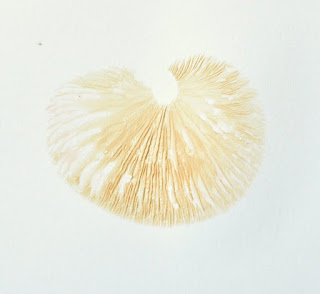A year or so ago my other half helped a friend remove some dead and dying trees from his garden, and we got to keep the wood for our fire. I noticed a few weeks ago that there were some fungi growing on some of the logs, so naturally I kept an eye on things, sketched some sketches, took some photos and tried to find out what they were (images are clickable to embiggen).
It became apparent that my little mushroom book wasn't up to the job, and searching the internet was a never-ending task when I didn't really know what I was looking for. I had a rather lovely and comprehensive guide to fungi on my wish list for Christmas (Mushrooms by Roger Phillips). This was elevated to 'To Buy: URGENT' status, and eureka! - there was my mushroom! I double-checked the ID with a facebook group (British & Irish Fungi - thanks!), who confirmed that what I had in my woodpile was the charmingly named Wrinkled Peach (Rhodotus palmatus).
Now the interesting thing about this mushroom, apart from its beautiful pink-orange colour, is the fact that it grows on elm logs; evidently our friend's trees were elms. This surprised me. I am not old enough to remember the British landscape before a virulent strain of Dutch Elm Disease struck in the late 1960s and devastated elms everywhere, and I thought that elms were largely absent these days. Not quite so...
Turns out that the reason that elms haven't been wiped out lies in the diversity of the elm family, which has evolved many races and hybrids. The tree reproduces by both seed and sucker; most kinds today in Britain produce suckers from their roots, forming clusters of genetically identical clones. Apparently many of the suckering types of elm can, for a time, survive the disease (which is caused by a fungus and spread by a beetle), even though they don't grow to the extent of the great, mature elms of old before succumbing and eventually regenerating through suckers once more. A very few (including the Boxworth elm, which grows in the village of Boxworth, just a few miles away from me here in Cambridgeshire) even reach maturity and seem to have some disease resistance.
A bit more delving led me to an interesting project: the Conservation Foundation's Great British Elm Experiment, which has been cultivating cuttings taken from resistant mature trees, including Boxworth elm. The planting phase of the project is drawing to a close, and the young trees will be monitored to see how they fare. Maybe one day we will see something like the elm-filled landscape of old again.
In the meantime, I have been marvellously diverted and educated by way of a small crop of Wrinkled Peaches!







I should have read your blog before commenting on your sketchbook! There are still a few elm trees around the US who seem to have survived the Dutch Elm disease also and I am old enough to remember some majestic elms on our farm as a youngster. Beautiful trees and I hope they do find some that are resistant to disease!
ReplyDeleteYour fungi are lovely and I adore the name 'Wrinkled Peaches'!!!
Hi Jan! I didn't realise that US elms had suffered the same fate as the European ones. So sad. Let's hope that the remaining trees evolve some resistance mechanisms, and that the elm project has some success.
Delete